Montessori Language Curriculum
Children’s language and literacy skills advance astonishingly in their first years of life. While all children start as newborn babies who rely primarily on tears to communicate, many children can fluently speak, write, and read in their native language by the time they turn 6. Montessori language curriculum uses an intuitive, hands-on approach to optimize language learning in these early, miraculous years.
While many parents want their children to enjoy the benefits of Montessori language learning, the approach may feel overwhelming at first. Montessori language curriculum differs from mainstream approaches to learning language and incorporates many materials that are new or different to parents.
In this article, we hope to make Montessori language curriculum simple, approachable, and accessible. We’ll explain the principles behind Montessori language theory, walk you through the basics of setting up a Montessori language area, and provide some examples of our favorite Montessori language works.
By the time you’re finished, you’ll feel confident in taking the first steps to incorporate Montessori language curriculum at home. Let’s get started!
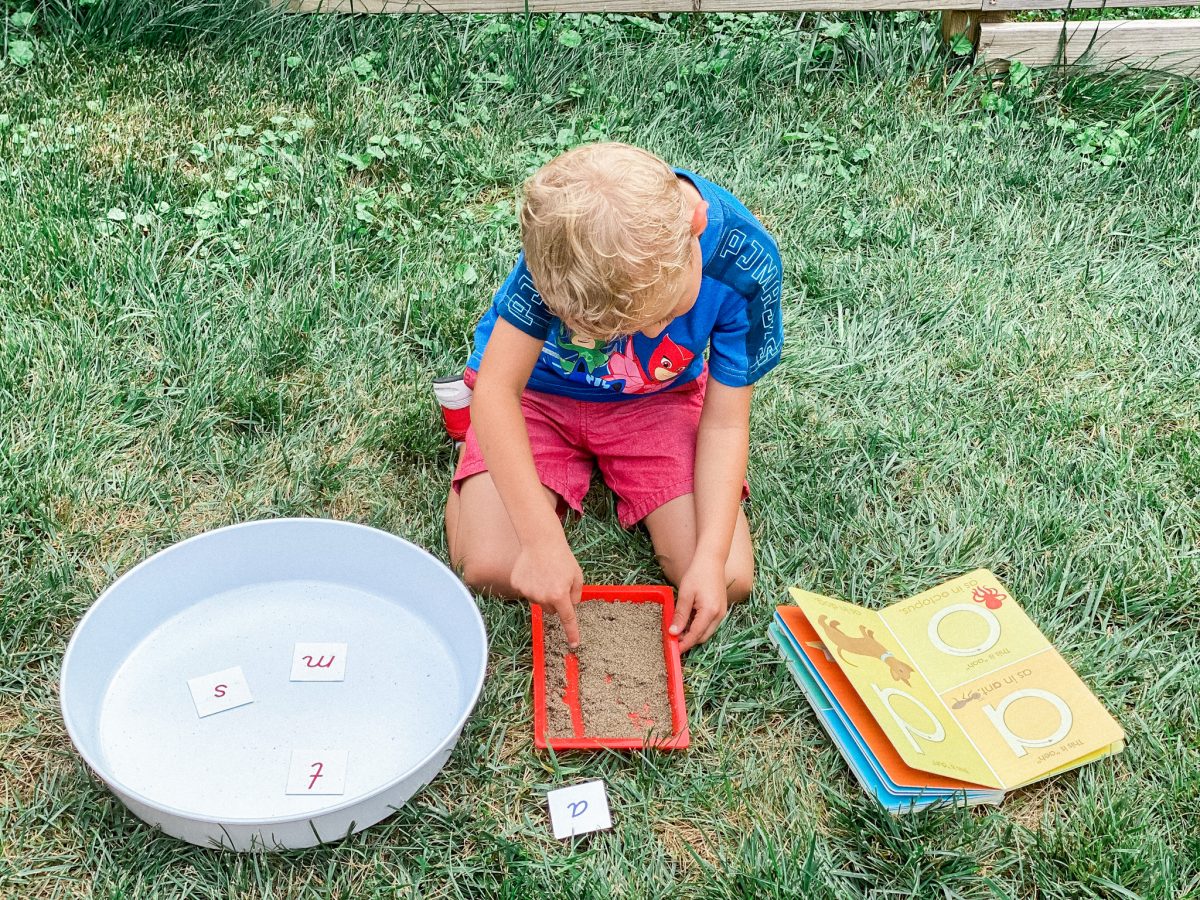
The Basics of Montessori Language Theory
Before getting into the specifics, let’s discuss a few key underlying principles that create the backbone for the Montessori language curriculum.
As always in Montessori, children learn language through hands-on materials. Instead of memorizing words on flashcards or looking at letters on a screen, children learn through tactile experiences that engage the senses.
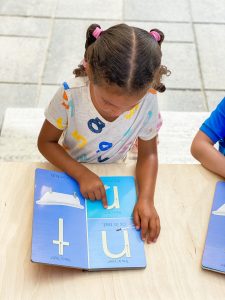 For example, when Montessori teachers first introduce written letters to students, they do so through sandpaper letters, boards that have each letter embossed on them with sandpaper. With this material, children are not only seeing the letter but also feeling it and hearing it as their teacher or parent makes the sound. Some sandpaper letter variations, like the language work book pictured from our Learning Language Toolbox, allow children to get the benefits of sandpaper letters without the higher price tag.
For example, when Montessori teachers first introduce written letters to students, they do so through sandpaper letters, boards that have each letter embossed on them with sandpaper. With this material, children are not only seeing the letter but also feeling it and hearing it as their teacher or parent makes the sound. Some sandpaper letter variations, like the language work book pictured from our Learning Language Toolbox, allow children to get the benefits of sandpaper letters without the higher price tag.
Another underlying principle behind Montessori language curriculum is the idea of mastering the concrete before moving to the abstract. Language learning can be very abstract — all letters and words are simply abstract representations of objects and ideas. Since abstract ideas can be difficult for children to understand, the Montessori method first introduces children to these ideas in their concrete form.
For example, before children learn the abstract, written letters that represent sounds, they master the sounds themselves. That means that long before a child sees the written letter “p,” they learn to identify the sound “puh” in language they’re familiar with, like through work with a small pearl language miniature.
Finally, Montessori language curriculum is child-led. Montessori teachers and parents carefully observe their child’s skills and interests and present language lessons when the child is developmentally ready. Children learn to write and read at their own pace and when they’re interested and ready to do so.
Read this blog article for more on Montessori language theory, including how and why it differs from traditional approaches.
Creating A Montessori Language Area
Setting up a Montessori language area at home doesn’t have to be difficult or complicated. You can start with any kind of low, accessible shelf. It doesn’t have to be fancy — even a wide windowsill or fireplace can work!
Since your home isn’t a Montessori classroom, you don’t need to have an entire shelf dedicated to language materials. It’s perfect to just have a few language works at a time that suit your child’s needs and skills.
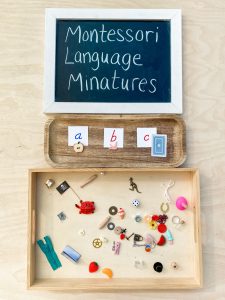 Next, it’s time to think about materials. This list of Montessori language activities by age can be a big help! Before jumping to an activity or material, it’s important to first observe your child before deciding which materials they’re ready for. Once you feel confident, you can prepare the materials and place them on the shelf.
Next, it’s time to think about materials. This list of Montessori language activities by age can be a big help! Before jumping to an activity or material, it’s important to first observe your child before deciding which materials they’re ready for. Once you feel confident, you can prepare the materials and place them on the shelf.
Make sure your child has everything they need to complete the work or activity. Trays and baskets work well for this! For example, if your child is ready to match language objects to sandpaper letters, you may include a small basket of objects alongside a few sandpaper letters, all contained in a tray.
Leave activities incomplete so your child can be the one to complete them. Place materials in ascending difficulty on the shelf from left to right with the easiest activity on the left and the most difficult on the right. For children, this preparation reinforces the way we read on a page — from left to right and from top to bottom!
Presenting Language Activities
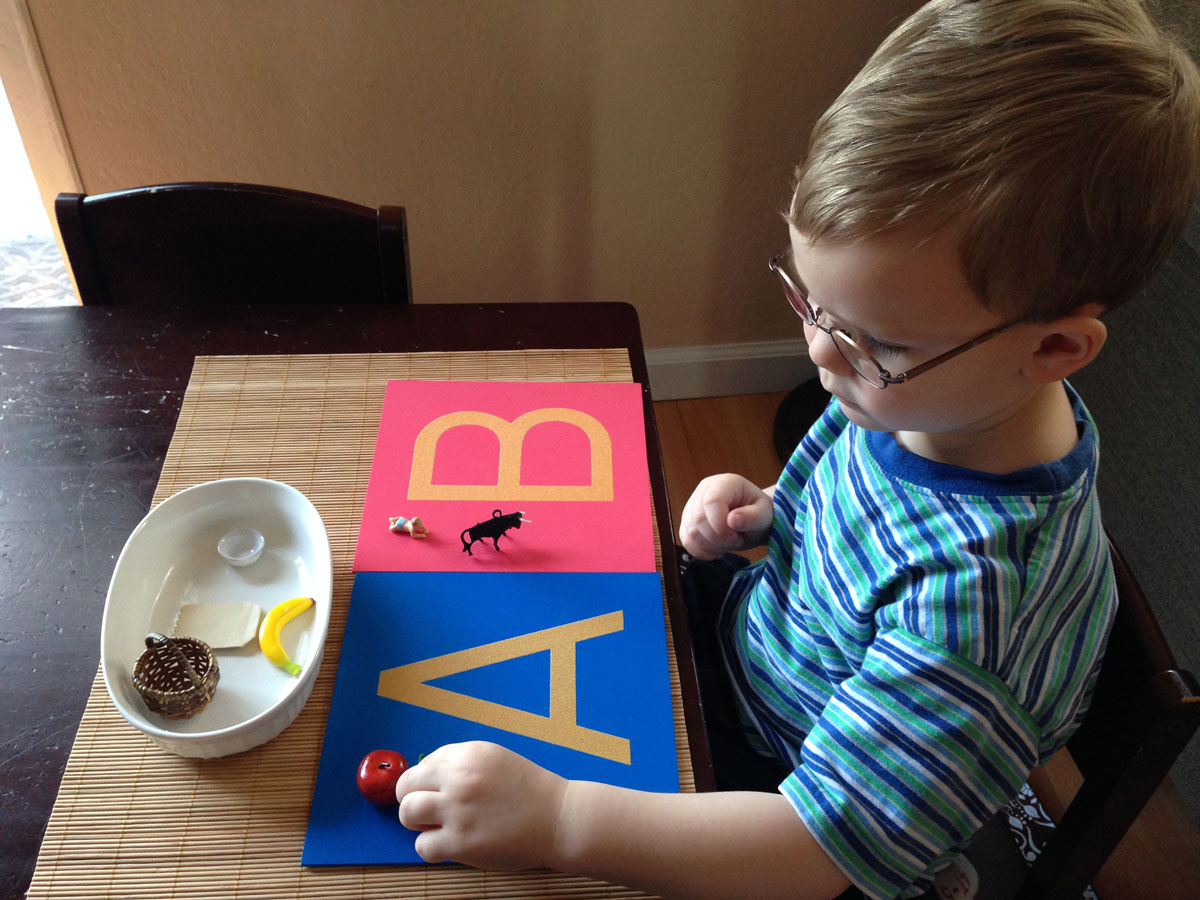
Once you’ve prepared your language area with thoughtfully chosen and presented materials, you can present the work to your child. Carefully carry the work to a workspace (a table or rug works perfectly!) and slowly present the work to your child, using as few words as possible, before inviting them to have a turn.
At this point, you’ve done your part as the prepared adult — now your child can choose when they’d like to work with the material!
Work Ideas for Your Montessori Language Area
Now that we’ve walked through a few basic principles of Montessori language curriculum and how to prepare a language area, we’ll now explore a few specific Montessori language works for children from about 3-6. We’ve divided these sections into oral language, pre-reading, and writing.
This list isn’t comprehensive — it just serves to get you started. For more activities, you can check out our blog post on Montessori language shelf ideas.
Oral Language
Before a child can learn to write or read, they must first master spoken language. Montessori language miniatures are one powerful tool to hone 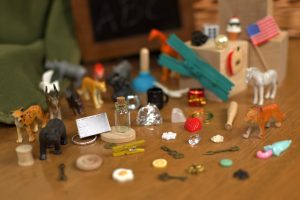 oral language skills in preparation for literacy. Using Montessori language miniatures, children can expand their vocabulary and learn to identify beginning, middle, and ending sounds.
oral language skills in preparation for literacy. Using Montessori language miniatures, children can expand their vocabulary and learn to identify beginning, middle, and ending sounds.
Montessori sound games are another great activity for children focusing on oral language. You can play sound games with language miniatures or objects found around the house. These games are like “Montessori I spy” — parents may say something like, “I spy with my little eye something that starts with ‘buh.‘” Once children have mastered the isolation of beginning sounds, you can play sound games with ending and eventually middle sounds.
Language baskets are another simple, inexpensive material for developing oral language. Gather a few related objects and place them in a basket on your child’s shelf. That’s it! Your child can explore the objects, learn their names, and practice describing them.
Pre-Reading
These materials and activities are best for children who have mastered sounds, starting with sandpaper letters. Sandpaper letters are a child’s first introduction to written letters. After a parent or teacher introduces a sandpaper letter and demonstrates the sound it represents, a child is ready to work with them.
One simple activity is to match language objects to the sandpaper letter that represents the object’s starting sound. For example, you may place the sandpaper letters for c, m, a, and t in a basket alongside a few corresponding language objects. Your child can then place the camel and candle with the c, the marlin and mug with the b, and so on.
Montessori three-part cards are another powerful language material even for pre-readers. And they’re easy to make on your own! These card sets feature one card with just a picture, a second card with the written label of the image, and a third card with both the image and label together (the control card.) Thanks to the third control card, children can practice matching these cards even before they know how to read.

Writing
Once a child has mastered letter sounds and their written counterparts, they’re ready to begin writing. In Montessori, writing actually precedes reading — Dr. Montessori noted that children learn to read more easily when they first create words on their own while writing.
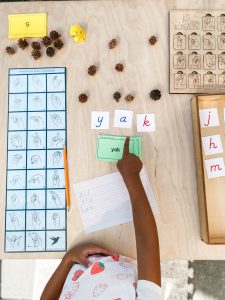 However, children’s small hands are often not developmentally ready to use a pencil even when they’re otherwise ready to write. The solution? The Montessori movable alphabet! These small wooden letters allow children to write even before they can physically do so with a pencil and paper. For a cost-effective DIY solution, you can even use a movable alphabet printed on paper.
However, children’s small hands are often not developmentally ready to use a pencil even when they’re otherwise ready to write. The solution? The Montessori movable alphabet! These small wooden letters allow children to write even before they can physically do so with a pencil and paper. For a cost-effective DIY solution, you can even use a movable alphabet printed on paper.
Thanks to the movable alphabet, children can practice basic word building. Start with simple CVC (consonant, vowel, consonant) words. You can print out an image of these words — like a hen, cow, or map — and your child can practice finding and placing the correct movable alphabet letters to create the word.
Metal insets are another important material to prepare children for writing. They consist of a shape with a metal knob within a larger frame. Children remove the shape and trace it onto paper and also trace the frame. This engaging works prepares children’s hands for every shape they’ll need to make to write the alphabet.
Getting Started
Now that you have a basic understanding of Montessori language curriculum and a few activity ideas, you’re ready to get started. Remember, Montessori at home doesn’t have to be elaborate or expensive. Starting with what you have on hand or a few DIY materials is just perfect!
We can’t wait to hear your experiences as you start Montessori language curriculum at home. Let us know how it goes in the comments below!




0 Comments